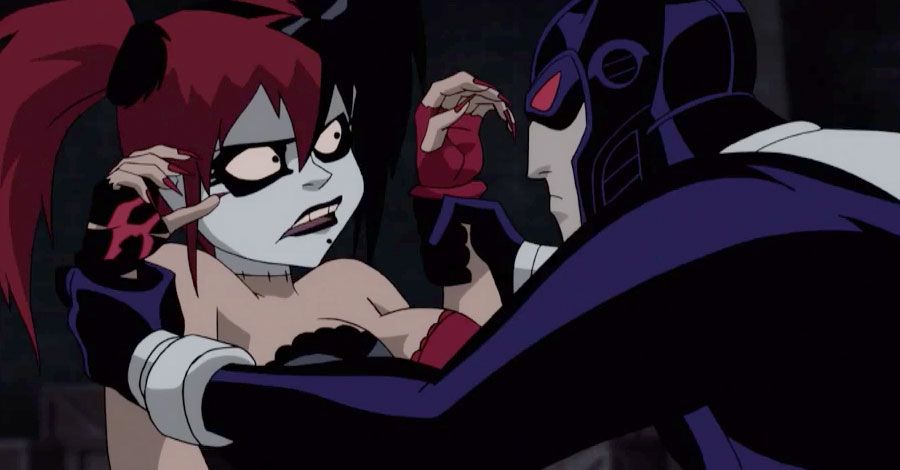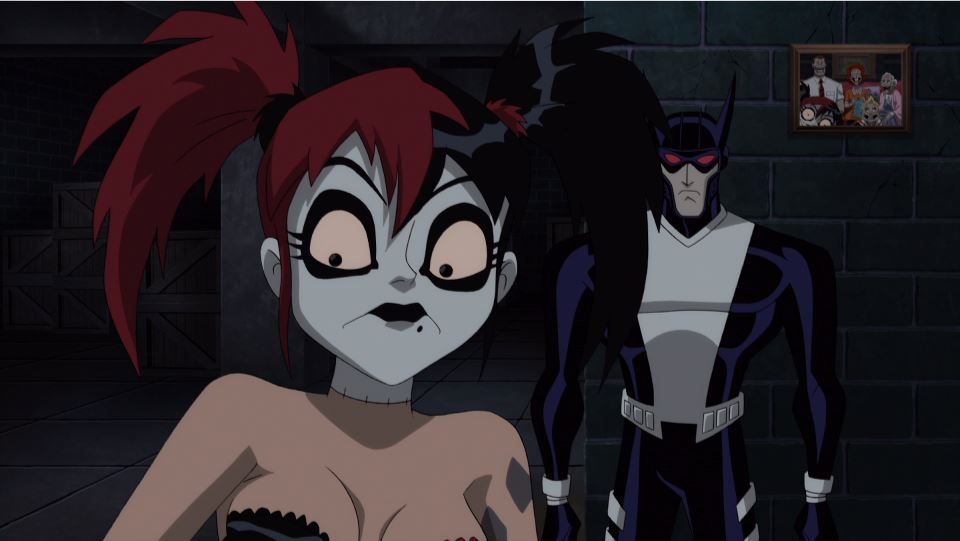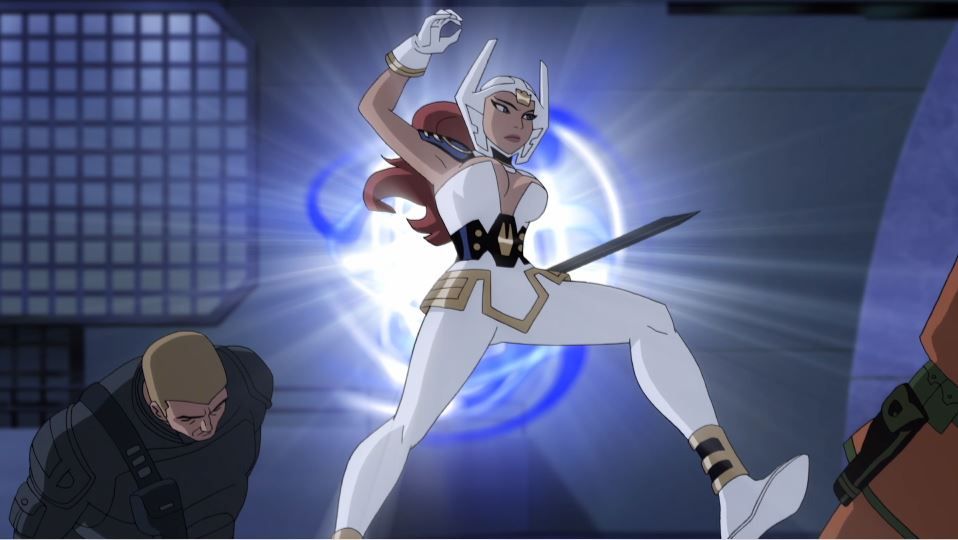DC Entertainment fans are no strangers to alternate universes where anything can and does happen -- but "Justice League: Gods and Monsters" will dive head first into a parallel world unlike any other.
The reality set forth in the upcoming direct-to-video animated film is dark, with a Superman, Batman and Wonder Woman vastly different from the ones familiar to fans. Batman is not Bruce Wayne, but instead a vampiric Kirk Langstrom (better known to DC fans as Man-Bat), Wonder Woman ties into the New Gods rather than the Greek pantheon, and Superman is the son of General Zod.
The Warner Bros./DC Entertainment film makes its debut July 28. However, fans have a chance to get a glimpse into this all-new world via three animated shorts on Machinima, the first of which debuts today and showcases the different relationship this world's Batman and Harley Quinn share.
Ahead of the new reality's debut, CBR News spoke with executive producer Bruce Timm about how "Chronicles" sets up the characters for his bigger story, what's going on with Bruce Wayne, Princess Diana and Kal-El in this alternate reality, and taking advantage of working within the webisodes' shorter format to shock viewers. "In a weird way, it opens us up and automatically puts us outside the box. All the rules that we know about how to normally tell a regular series of any regular show in a 22-minute length are superfluous. It's completely irrelevant," Timm told CBR of telling stories in the seven-minute format. "We have to make new rules. It's been freeing."
This webseries introduces us to the new takes on Superman, Batman and Wonder Woman for the first time. The episodes are pretty short, so what aspects about these characters did you try to convey the most in the allotted time?
Bruce Timm: Well, the initial three-episode webseries was deliberately designed to showcase each of these characters in a way that automatically smacks you upside the head and says, "Forget everything you know about who Superman or Batman or Wonder Woman is." These are all-new versions of those characters. In knowing that these were going to air before the movie came out, [I thought] it would be a great little mini-teaser of the characters. Each short was intentionally designed to be -- I'll be blatant about it -- they were intended to be shocking a little bit. We probably went a little bit further with each of them than we normally would have been inclined to do. But again, knowing that it was trying to make an impact, trying to make a statement, trying to be the squeaky wheel that gets the grease.
I have mentioned this before, one of the things that intrigues me about these characters is the fact that they have a completely different sense of moral obligation and duty than the traditional Justice League. They will cross lines that the traditional Justice League characters won't.
A couple years back when the "Man of Steel" came out, I remember the frenzy of the fans when they said, "Oh, I can't believe Superman killed General Zod! Superman would never do that." When I was watching the movie, my first thought was, "Well, dang, I wanted to do that in the Doomsday movie, when we had Superman versus Doomsday." I was going to have Superman do exactly the same deed. Doomsday was going to be getting ready to kill some innocent bystanders, and Superman was already mortally wounded, and he was going to use his last bit of strength to break Doomsday's neck. DC wouldn't let me do it. I said, "OK, well this version of Superman can do that." Nobody could ever say Superman can't do that. This version of Superman, we don't know what he's going to do.
For instance, the Batman episode: Again, we wanted it to be somewhat familiar, so we wanted to use an existing DC villain, and it was a semi-familiar Gotham City. But what would make this really different from traditional Batman and traditional Harley? We said, "Well, if this Harley is a really twisted, extreme serial-killer version of Harley, then all bets are off." That's what we kind of did there. Each of these three shorts is designed deliberately to say, "Oh, hang on a sec! What's going on here?"
When you're doing something this extreme and this flipped, do you try to keep any threads of the character's origins or things we know, or is that just completely out the window?
It's weird. There's no hard and fast rules about how far to take these characters, or how far not to take them. Some of the characters, like Harley, are not that completely different from their traditional counterparts, except this one's a homicidal maniac. For instance, Lois Lane shows up in the movie. She's still a news reporter. The biggest change that she has is that her whole attitude about Superman is 180 degrees away from the traditional Lois. This Lois hates Superman's guts. She built her career out of trying to tell the world that this guy that everybody thinks is so wonderful is actually a dick.
But then, some of the other characters, we tried to keep something about them that's similar to the DC Universe. I keep saying that it's a genuine alternate universe in that our changes aren't completely random, but it's like a tangent. This character could have gone that way, but he went this way instead. Several reporters have asked me about Bruce Wayne, and I'll just say straight out: "The only thing I know about Bruce Wayne for sure is that his parents didn't go out to the movies that night and didn't end up getting killed in Crime Alley. So he didn't grow up to become Batman. He became something else." Technically, as far as we know, he exists in this universe. Kal-El doesn't. He was never conceived. Are we ever going to get to Paradise Island and see what happened to the real Wonder Woman? Maybe. Maybe not. For right now, it's all about -- I keep going back to that Green Lantern template -- keep the name and the gimmick, maybe a little bit of what that character means in the DC Universe, and then put a really weird spin on it and see where it goes.
Besides telling new stories, the changes also give you the opportunity to design new costumes. I want to talk about Wonder Woman's look. It looks like she has New Gods-inspired armor.
Totally.
In designing all the new looks, what were some considerations that came into play?
Speaking of Wonder Woman, that's interesting, because her design came first. Initially, we were sticking a little bit closer to the DC version of her. We were actually sticking with the whole Greek mythology background, but I had always done that drawing of her just as a way of loosening myself up. I didn't want to do the stars and the stripes and the eagle and all of that stuff. I wanted to do something really different. I've always been a Jack Kirby fan. In the back of my head, I was thinking, "If we're going to do Greek mythology, it doesn't have to look like 2,000 years ago Greek style. It can be like a Jack Kirby version of that." It's like what he did with Thor. It was Norse mythology, but with all this weird pseudo-science on top of it. I was thinking along those lines, I came up with this Kirby-ish version of her costume and then we soon realize the whole Greek mythology thing wasn't really working for us. It was not different enough.
I was talking about all of this with Alan Burnett, who wrote the movie and has been helping me develop this whole series. He looked at it and said, "Why don't you go with the New Gods, because she kind of looks like a Kirby character anyways." And I went, "Ah, the New Gods!" I had given her red hair and that made me think of this character Bekka from the comics, and so I was off. That's it. That's not Greek mythology. That gave us a launching point for her.
Superman's look was, honestly, the toughest. The only thing I knew was that I didn't want him to have a big red and yellow diamond on his chest or on his costume. I actually even resisted putting an "S" on him anywhere. To a degree, I just wanted to get him out of spandex because I didn't want him to have a traditional super hero look. I wanted to do something different with him, but I didn't really know what that meant. I kept stripping him back and stripping him back, to the point where it almost became boring, where he's just wearing a turtleneck and tight pants and jack boots. You have to jazz it up somehow. I thought, "Oh, I'll put a leather coat on him. This looks cool." Then I started drawing him in motion and the way his coat would flap in the breeze, I thought, "Wow, that looks a little like a cape. That's kind of cool." So it was a weird accident.
This is your first animated project in a while. What it's like getting back into the medium in this particular way, what with its multimedia approach?
It has been a blast so far. It came about not by accident, but kind of as a fluke. It started with my boss, Sam Register, mentioning to me that they were thinking about rebooting the "Justice League" animated series. But he said they didn't want to just go back and do a direct continuation of the old show, they wanted to do something really fresh and different and new. He said if I have any ideas to let him know. I said, "OK, I'll think about it." So I was thinking about that.
Around the same time, DC Comics was doing the New 52, the big reboot, and for some reason it made me think of when they brought back the Green Lantern and The Flash back in the late '50s, and they basically threw out almost everything that made them who they were in the Golden Age. They basically kept their name and the gimmick, and they gave them all new origin stories, new powers, new costumes and new alter egos, and I thought, "Wouldn't that be cool if you did that same level of reboot with the big three who are normally untouchable?" I started bouncing some ideas around and came up with what ultimately became the new "Gods and Monsters" versions of Superman, Batman and Wonder Woman. I pitched it to Sam and he said, "Wow, that's really cool!" He thought it was probably a little too extreme for a TV series. He said, "I probably want to stay a little more traditional than that, but it would probably make a really excellent direct-to-video movie." I thought, "OK, that would work." So I pitched it to home video. They loved it and off we went.
Once we started to get going, DC Comics got excited about the idea, they said, "Oh, we'd like to do a comic book tie-in." I said, "OK, that would be great." So we're doing that. Then Machinima got wind of it and said, "This is really exciting -- the whole Justice League idea. We would love to do shorts or a webseries based on those versions of the characters." It just snowballed. It has been fun.
I know we're still at the beginning of the "Gods and Monsters" story, but you already know you have Season Two ordered. Where are you in development for stories in that season?
It is still in a pretty early phase. We are still breaking the stories for it. We have a rough idea of what we're going to do. It's been really tricky, because on one hand, it is like an actual season of a regular TV show where it does have a bit of a story arc that pays off at the end of the season. At the same time, Machinima was really insistent that each episode not end with "To be continued..." They wanted each episode to be more of a standalone. I was like, "OK, we're going to try and have our cake and eat it." It's been fun figuring out exactly how to do that. It's actually been great. The fact that the lengths are so short -- in a weird way, it opens us up and automatically puts us outside the box. All the rules that we know about how to normally tell a regular series of any regular show in a 22-minute length are superfluous. It's completely irrelevant.
We have to make new rules. It's been freeing. Since they're only seven minutes long, and there's a good number of them, then we can afford to take some episodes that aren't even about Superman and Batman or whoever. It could be just about introducing a new Justice League member, and be just all about them.
"Justice League: Gods and Monsters Chronicles" begins June 8. The animated feature film directed by Sam Liu, produced by Timm and Alan Burnett, and starring Benjamin Bratt, Michael C. Hall, and Tamara Taylor, arrives July 28.




